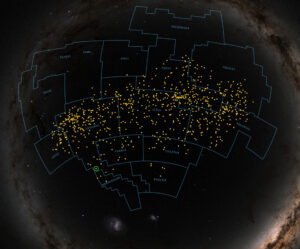Using observations from NASA’s Transiting Exoplanet Survey Satellite (TESS), a team of astronomers has discovered a trio of hot worlds larger than Earth orbiting a much younger version of our Sun. Called TOI 451, the system resides in the newly discovered Pisces-Eridanus stream, a collection of stars less than 3% the age of our solar system that stretches across one-third of the sky.
The planet was identified and validated by the THYME collaboration, which is led by professors Andrew Mann of UNC Chapel Hill and Elisabeth Newton of Dartmouth College. THYME includes UNC graduate students Mackenna Wood and Pa Chia Thao, both of whom were co-authors on the study. The collaboration focuses on identifying planets much younger than the Sun to study how planets change with time.
“This discovery was only possible because of TESS’s wide field of view, which is essential to surveying the whole stream” said Dr. Mann. Jessie Christiansen, a co-author of the paper and the deputy science lead at the NASA Exoplanet Archive added, “TESS data will continue to allow us to push the limits of what we know about exoplanets and their systems for years to come.”
Archival infrared data from NASA’s Near-Earth Object Wide-Field Infrared Survey Explorer (NEOWISE) satellite – collected between 2009 and 2011 under its previous moniker, WISE – suggests the system retains a cool disk of dust and rocky debris. They picture it as a diffuse ring of rock and dust centered about as far from the star as Jupiter is from our Sun.
TESS spots new worlds by looking for transits, the slight, regular dimmings that occur when a planet passes in front of its star from our perspective. Transits from all three planets are evident in the TESS data. The THYME team obtained follow-up measurements from NASA’s retired Spitzer Space Telescope and SOAR observatory to better characterize the planetary system.
“This system checks a lot of boxes for astronomers,” said Dr. Newton. “It’s only 120 million years old and just 400 light-years away. The planets are between two and four times Earth’s size and are especially promising targets for testing theories about how planetary atmospheres evolve.”
TOI 451, better known to astronomers as CD –38 1467, lies about 400 light-years away in the constellation Eridanus. It has 95% of our Sun’s mass, but it is 12% smaller, slightly cooler, and emits 35% less energy. TOI 451 rotates every 5.1 days, which is more than five times faster than the Sun.
Even the most distant planet in the TOI 451 system orbits its star three times closer than Mercury ever approaches to the Sun, so all of these worlds are quite hot and inhospitable to life as we know it. Temperature estimates range from about 2,200 degrees Fahrenheit (1,200 degrees Celsius) for the innermost planet to about 840 F (450 C) for the outermost one.
TOI 451 b orbits every 1.9 days, is about 1.9 times Earth’s size, and its estimated mass ranges from two to 12 times Earth’s. The next planet out, TOI 451 c, completes an orbit every 9.2 days, is about three times larger than Earth, and holds between three and 16 times Earth’s mass. The farthest and largest world, TOI 451 d, circles the star every 16 days, is four times the size of our planet, and weighs between four and 19 Earth masses.
Astronomers expect planets as big as these to retain much of their atmospheres despite the intense heat from their nearby star. Different theories of how atmospheres evolve by the time planets reach TOI 451’s age predict a wide range of properties. Observing starlight passing through the atmospheres of these planets provides an opportunity to study this phase of development and could aid in constraining current models.
“By measuring starlight penetrating a planet’s atmosphere at different wavelengths, we can infer its chemical composition and the presence of clouds or high-altitude hazes,” said Elisa Quintana, an astrophysicist at NASA’s Goddard Space Flight Center in Greenbelt, Maryland. “TOI 451’s planets offer excellent targets for such studies with Hubble and the upcoming James Webb Space Telescope.”
TESS is a NASA Astrophysics Explorer mission led and operated by MIT in Cambridge, Massachusetts, and managed by NASA’s Goddard Space Flight Center. Additional partners include Northrop Grumman, based in Falls Church, Virginia; NASA’s Ames Research Center in California’s Silicon Valley; the Center for Astrophysics | Harvard & Smithsonian in Cambridge, Massachusetts; MIT’s Lincoln Laboratory; and the Space Telescope Science Institute in Baltimore. More than a dozen universities, research institutes, and observatories worldwide are participants in the mission.
NASA’s Jet Propulsion Laboratory in Southern California manages NEOWISE for NASA’s Science Mission Directorate in Washington. Ball Aerospace & Technologies Corp. of Boulder, Colorado, built the spacecraft. Science data processing takes place at IPAC at Caltech in Pasadena. Caltech manages JPL for NASA.
A paper reporting the findings was published on Jan. 14 in The Astronomical Journal and is available online.
Original release by Francis Reddy
NASA’s Goddard Space Flight Center, Greenbelt, Md.
Modifications by Andrew Mann
UNC Chapel Hill, Chapel Hill, NC
This illustration sketches out the main features of TOI 451, a triple-planet system located 400 light-years away in the constellation Eridanus.
Credit: NASA’s Goddard Space Flight Center
Psc-Eri stream:
The Pisces-Eridanus stream spans 1,300 light-years, sprawling across 14 constellations and one-third of the sky. Yellow dots show the locations of known or suspected members, with TOI 451 circled. TESS observations show that the stream is about 120 million years old, comparable to the much more compact Pleiades cluster in Taurus (upper left). Astronomers don’t know how the two otherwise similar clusters evolved so differently.
Credit: NASA’s Goddard Space Flight Center
For NASA’s official press release please follow the link: TESS Discovers New Worlds in a River of Stars | NASA


